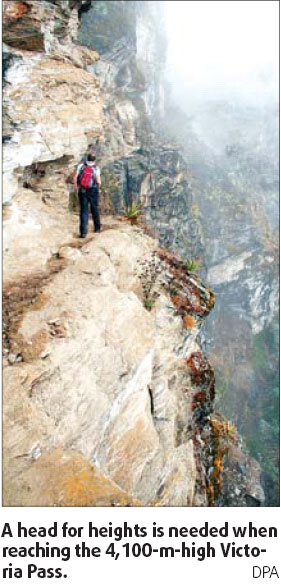At this altitude, the views are breathtaking
CUZCO, Peru: A final ascent and the last pass was crossed. At 3,100 m above sea level, the lost Incan city of Choquequirao came into view. The name means "Cradle of Gold" in Quechua, the Incan language.
Sometimes the ruined city is called Machu Picchu's "sister" because of its similarity to the famous tourist magnet in the Peruvian Andes. Offering views deep into the Apurimac Valley, Choquequirao is indeed an alternative to overcrowded Machu Picchu.
Some 2,000 visitors daily now swarm over Machu Picchu, and every year about 500 hiking groups with up to 40 members each get in each other's way on the Inca Trail. But adventurers have Choquequirao almost all to themselves - except for the archaeologists, whom they can watch at work.
Choquequirao is situated almost 45 km from Machu Picchu. Only about a quarter of it has been excavated to date. The city is thought to have been one of the last bastions of Incan resistance to the Spaniards in the 16th century.

It has aqueducts, temples, residential buildings and fountains. The white stone llamas embedded in the walls of the large terraces are famous.
Choquequirao was long forgotten. Excavations began in 1986, and the first hikers arrived in 1993. So far, the site has not changed much. Only about 60 tourists visit in a week. There is neither road nor rail access, and the hikers' trail is strenuous.
Cachora, the nearest town, is a six-day trek away. A longer, more demanding route goes from Huancalle to Cachora via Choquequirao. It takes 13 days and sees only about 20 groups a year.
A trek of about 90 km on foot is needed to get from Huancalle to Choquequirao. Hikers pass through the gorges of the Vilcabamba region, the Incas' last refuge. In 1537, Inca ruler Manco Inca rebelled against the Spanish conquistadores. After losing the battle of Cuzco, once the Incan capital, he retreated with his followers to Vilcabamba to found a new state.
Subsequently, the Incas were able to build new cities for many years - dozens of sites dot the region. But tourists seldom venture into this remote corner of the Andes.
Experiencing Choquequirao is rough. Hikers sleep in tents beside mountain streams or on mountain ledges with panoramic views. They are on the move for about eight hours daily, which is not easy at elevations sometimes exceeding 4,000 m above sea level.
On the second day, the trail climbed to the snow-covered Choquetacarpo Pass, 4,635 m above sea level.
Up and down the Inca trails went, amid snow-capped peaks of 5,000 m and more. Fog kept the hikers close to the rock face. They passed old silver mines and reached Victoria Pass, 4,100 m up.
The night was spent in Maizal, on a mountain ledge overlooking the Incan terraces of Pichinuyoc. Twenty workers were restoring the 80 terraces and cult sites there. The tents were pitched right next to the ruins.
All of this was pure adventure. But the highlight did not come until the following day: Choquequirao.
DPA
(China Daily 03/20/2008 page20)














